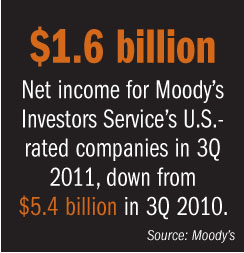When looking at the property and casualty industry’s performance for the first nine months of 2011, or even just the third quarter, the news is the same: sharply declining profits and underwriting results compared to the same periods in 2010, according to three recent reports.
 Fitch Ratings analyzed a group of 47 publicly traded U.S. and non-U.S. insurers and reinsurers through the first nine months of 2011 and found the aggregate net profit was $9.7 billion, compared with a net profit of $26.4 billion during the same period last year.
Fitch Ratings analyzed a group of 47 publicly traded U.S. and non-U.S. insurers and reinsurers through the first nine months of 2011 and found the aggregate net profit was $9.7 billion, compared with a net profit of $26.4 billion during the same period last year.
Shortly after the Fitch report, Moody’s Investors Service released a Special Comment stating that aggregate net income for its U.S.-rated companies in 2011’s third quarter was $1.6 billion, down sharply from the 2010 third quarter when net income was $5.4 billion.
Recommended For You
Want to continue reading?
Become a Free PropertyCasualty360 Digital Reader
Your access to unlimited PropertyCasualty360 content isn’t changing.
Once you are an ALM digital member, you’ll receive:
- Breaking insurance news and analysis, on-site and via our newsletters and custom alerts
- Weekly Insurance Speak podcast featuring exclusive interviews with industry leaders
- Educational webcasts, white papers, and ebooks from industry thought leaders
- Critical converage of the employee benefits and financial advisory markets on our other ALM sites, BenefitsPRO and ThinkAdvisor
Already have an account? Sign In Now
© Touchpoint Markets, All Rights Reserved. Request academic re-use from www.copyright.com. All other uses, submit a request to [email protected]. For more inforrmation visit Asset & Logo Licensing.







